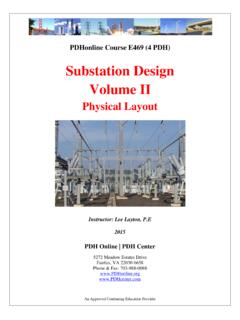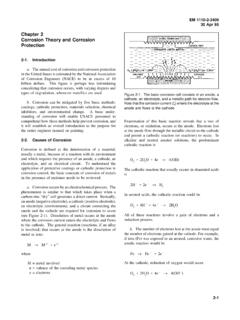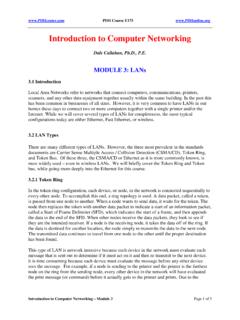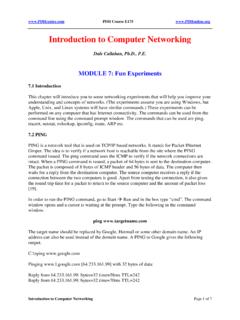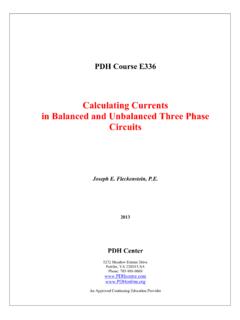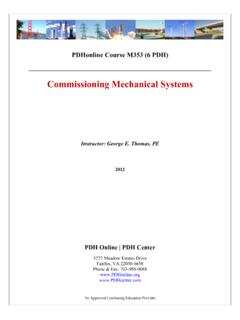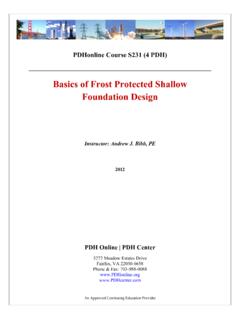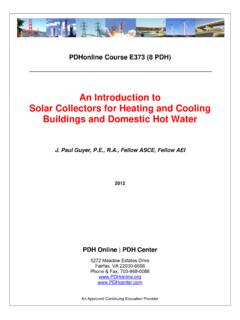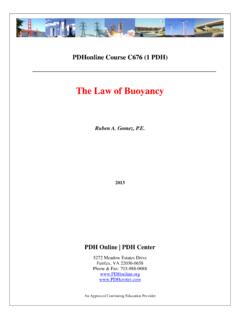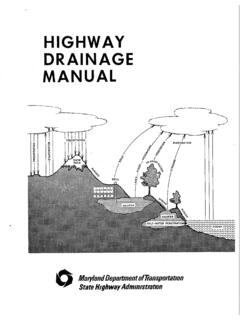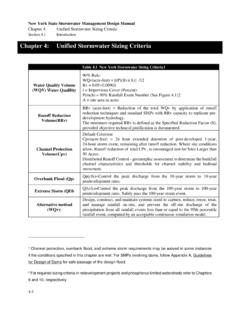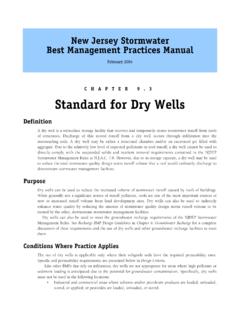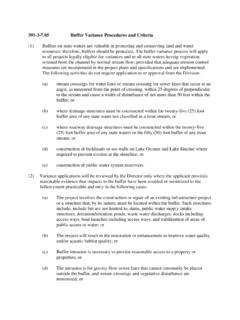Transcription of The Basics of Culvert and Inlet Design
1 An Approved Continuing Education Provider PDHonline Course C619 (8 PDH) The Basics of Culvert and Inlet Design Jerry D. Morrow, PE 2013 PDH Online | PDH Center 5272 Meadow Estates Drive Fairfax, VA 22030 6658 Phone & Fax: 703 988 0088 PDHonline Course C619 2013 Jerry D. Morrow Page 2 of 63 The Basics of Culvert and Inlet Design Introduction The Design of a Culvert is influenced by cost, hydraulic efficiency, purpose, and the topography at the proposed Culvert site.
2 Thus physical data must be integrated with engineering and economic considerations. The information contained in this chapter should give the Design engineer the ability to Design culverts taking into account the factors that influence their Design and selection. While computer programs are often used for Design , the input data requires knowledge what effects the data has and what conditions must be evaluated. While most of the recommendations made herein are commonly accepted, they are the opinion of the writer and local standards will always prevail. Definition Culverts are structures used to convey surface runoff through embankments. Culverts are usually covered with embankment and composed of structural material around the entire perimeter, although some are supported on spread footings with the streambed serving as the bottom of the Culvert .
3 For economy and hydraulic efficiency, culverts should be designed to operate with the Inlet submerged during flood flows, if conditions permit. Cross drains are those culverts and pipes that are used to convey runoff from one side of a roadway to another. Purpose The primary purpose of a Culvert is to convey surface water across or from the roadway right of way. In addition to the hydraulic function, a Culvert must also support the embankment and roadway for traffic conveyance, and protect the traveling public and adjacent property owners from flood hazards to the extent practicable and in a reasonable and prudent manner. Considerations Primary considerations for the final selection of any drainage structure are that its Design be based upon appropriate hydraulic principles, economy, and minimized effects on adjacent property by the resultant headwater depth and outlet velocity.
4 In addition to sound hydraulic Design , sound structural Design , site Design , and construction practices are necessary for a Culvert to function properly. The allowable headwater elevation is that elevation above which damage may be caused to adjacent property and/or the roadway. It is this allowable headwater depth that is the primary basis for sizing a Culvert . To ensure safety during major flood events, access and egress routes to developed areas should be checked for the 100 year flood to determine if these streets will provide safe access for emergency vehicles and local residents. Bridge or Culvert Selection At many sites, either a bridge or a Culvert will fulfill the structural and hydraulic requirements.
5 The structural choice should be based on: PDHonline Course C619 2013 Jerry D. Morrow Page 3 of 63 1. Risk of property damage, 2. Construction and maintenance costs, 3. Traffic safety, 4. Environmental considerations, 5. Risk of failure, and 6. Aesthetic considerations. Symbols, Definitions and Units TABLE 1 A Area of cross section of flow sq. ft. B Barrel width ft. Cd Overtopping discharge coefficient D Culvert diameter or barrel depth in. or ft. d Depth of flow ft.
6 Dc Critical depth of flow ft. du Uniform depth of flow ft. g Acceleration of gravity H Total energy loss ft. He Entrance head loss ft. Hf Friction head loss ft. ho Height of hydraulic grade line above outlet invert ft. HW Headwater depth above invert of Culvert (depth from Inlet invert to upstream total energy grade line) ft. Ke Inlet loss coefficient L Length of Culvert ft. P Empirical approximation of equivalent hydraulic grade line ft. Q Rate of discharge cfs S Slope of Culvert TW Tailwater depth above invert of Culvert ft. PDHonline Course C619 2013 Jerry D. Morrow Page 4 of 63 V Mean velocity of flow Vc Critical velocity Concept Definitions Critical Depth Critical depth can best be illustrated as the depth at which water flows over a weir, this depth being attained automatically where no other backwater forces are involved.
7 For a given discharge and cross section geometry there is only one critical depth. Uniform Flow Uniform flow is flow in a prismatic channel of constant cross section having a constant discharge, velocity and depth of flow throughout the reach. This type of flow will exist in a Culvert operating on a steep slope provided the Culvert is sufficiently long. Free Outlets Free outlets are outlets whose tailwater is equal to or lower than critical depth. For culverts having free outlets, lowering of the tailwater has no effect on the discharge or the backwater profile upstream of the tailwater. Submerged Outlets Partially submerged outlets are outlets whose tailwater is higher than critical depth and lower than the height of the Culvert .
8 Submerged outlets are outlets having a tailwater elevation higher than the soffit of the Culvert . Submerged Inlets Submerged inlets are those inlets having a headwater greater than about one and one half times the diameter of the Culvert . Improved Inlets Flared, improved, or tapered inlets indicate a special entrance condition which decreases the amount of energy needed to pass the flow through the Inlet and thus increases the capacity of culverts at the Inlet . Soffit Soffit refers to the inside top of the Culvert . The soffit is also referred to as the crown of the Culvert . PDHonline Course C619 2013 Jerry D.
9 Morrow Page 5 of 63 Invert Invert refers to the flowline of the Culvert (inside bottom). Steep and Mild Slope A steep slope Culvert operation is where the computed critical depth is greater than the computed uniform depth. A mild slope Culvert operation is where critical depth is less than uniform depth. Culvert Design Steps Following are the recommended steps in the Design of a Culvert in order to ensure that all Design aspects are taken into account. Step 1: Determine And Analyze Site Characteristics Site characteristics include the generalized shape of the roadway embankment, bottom elevations and cross sections along the stream bed, the approximate length of the Culvert , and the allowable headwater elevation.
10 In determining the allowable headwater elevation, roadway elevations and the elevation of upstream property should be considered. The consequences of exceeding the allowable headwater elevation should be evaluated and kept in mind throughout the Design process. Culvert Design is actually a trial and error procedure because the length of the barrel cannot be accurately determined until the size is known, and the size cannot be precisely determined until the length is known. In most cases, however, a reasonable estimate of length will be accurate enough to determine the Culvert size. Step 2: Perform Hydrologic Analysis Delineate the drainage area above the Culvert site.
